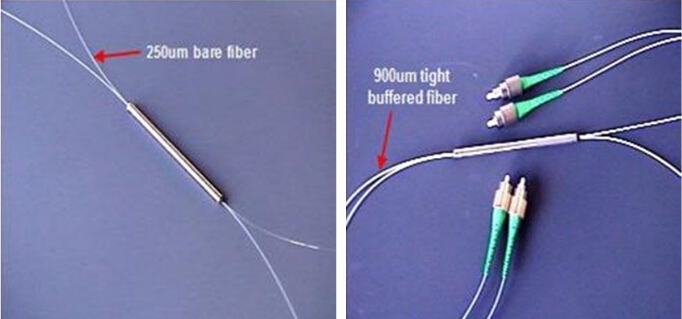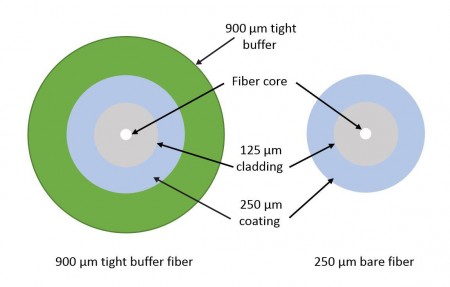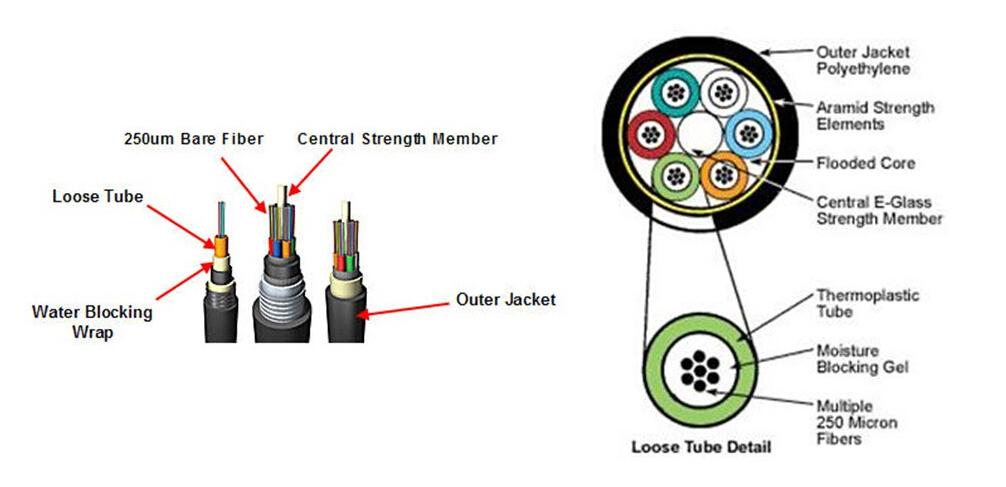As we know that there generally exist two basic structures of fiber—loose-tube 250um fiber and tight-buffered 900um fiber, have you ever wondered what the difference is between them? Actually loose-tube 250um fiber and tight-buffered 900um fiber both start with the same 250um bare fibers. Therefore, they feature the same size fiber core (50 um for multimode and 9 um for single-mode), 125um cladding and soft 250um coating. The difference between the two, however, lies in the cable construction.
The Structure of 250um Fiber and 900um Fiber
Most of the fibers come down to two basic configurations—250um coated fiber (also called bare fibers) and tight-buffered 900um fiber. Actually tight-buffered fibers cover a coated fiber (the coating is soft plastic) with a thick layer of harder plastic, making it easier to handle and providing physical protection. So, let’s firstly look at the structure of each fiber.

The Structure of a 250um Coated Fiber (Bare Fiber)
- Core (9um for standard single mode fibers, 50um or 62.5um for multimode fibers)
- Cladding (125um)
- Coating (soft plastic, 250um is the most popular, sometimes 400um is also used)
The Structure of 900um Tight-buffered Fiber
- Core (9um for standard single mode fibers, 50um or 62.5um for multimode fibers)
- Cladding (125um)
- Coating (soft plastic, 250um)
- Tight buffer (hard plastic, 900um)

The Differences Between Loose-tube 250um Fiber and Tight-buffered 900um Fiber
Based on 900um tight buffered fiber and 250um coated fiber there are two basic types of fiber optic cable constructions—loose-tube 200um cable and tight-buffered 900um cable. So, next we will explain the difference between them.
Differences in the Layer
Distinct from loose-tube 200um fiber, tight-buffered 900um fiber adds an additional 900um layer of hard plastic over the 250um fibers for protection. Within the cable, several of these color-coded 900um tight buffered fibers are situated around a central strength member, and then covered with Kevlar or aramid yarn for protection, a rip cord and then the jacket.

Fiber counts of tight-buffered 900um fiber cable typically range from 2 to 144 fibers, with larger fiber counts featuring fiber subunits of 6 or 12 fibers within the cable. For example, a 144-fiber cable usually has twelve 12-fiber subunits while a 36-fiber cable could have six 6-fiber subunits or three 12-fiber subunits.
Differences in the Tubes
Loose-tube 250um fiber places up to 12 bare 250um fibers inside a flexible plastic tube, which are also color coded and situated around a central strength member with Kevlar or aramid yarn for protection. The fiber counts of loose-tube 250um fiber cable range from 6 to 144, and besides the 6-fiber cable, the fibers are also grouped into sets of 12 for maximum density. Loose-tube 250um fiber cables are less than half the size of 900um fiber cables.

Buffered loose-tube cables feature an outer waterblocking tape around the tubes, beneath the outer jacket. The tubes are gel-filled to prevent water migration, or they are available with a dry waterblocking technology—sometimes referred to as gel-free cable. These materials are proved to be essential to prevent water from migrating into the tubes, as well as protect the fiber from freezing, expanding and breaking by water. Meanwhile, the dry waterblocking technology also dramatically reduces installation time by eliminating the need to clean off the gel prior to termination.
Applications of 250um Fiber and 900um Fiber
Generally, tight-buffered 900um fiber cables are usually employed for indoor applications, like intra-building riser, plenum applications and in data centers, whereas loose-tube 250um fiber cables are typically used in outside plant (OSP) applications, such as inter-building duct, aerial and direct buried installations.
Indoor/outdoor cables have the advantage of eliminating the need for service entrance splicing to in-building cable. And OSP loose-tube 250um cabling must be terminated within 50 feet of entering a facility. So, breakout kits are used to build the 250um cable up for protection and termination to 900um connector boots. With breakout kits, therefore, will add material costs and a significant amount of labor. One option is to terminate the 250um fiber directly to 250um connector boots. This can speed network deployment in the data center and fiber-to-the-home applications.
Conclusion
To sum it up, the difference of loose-tube 250um fiber and tight-buffered 900um fiber mainly lies in the cable construction, that tight-buffered 900um fiber with an additional layer and loose-tube 250um fiber with a gel-filled or waterblocking tube. Knowing the configurations and features of fiber cables would help to make an optimum alternation in different occasions and applications.

No comments:
Post a Comment